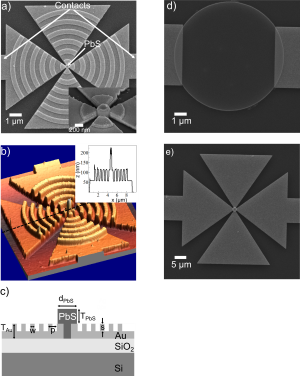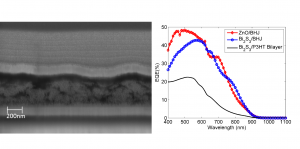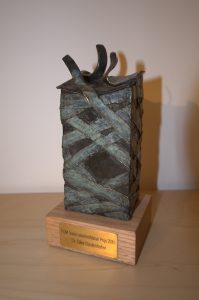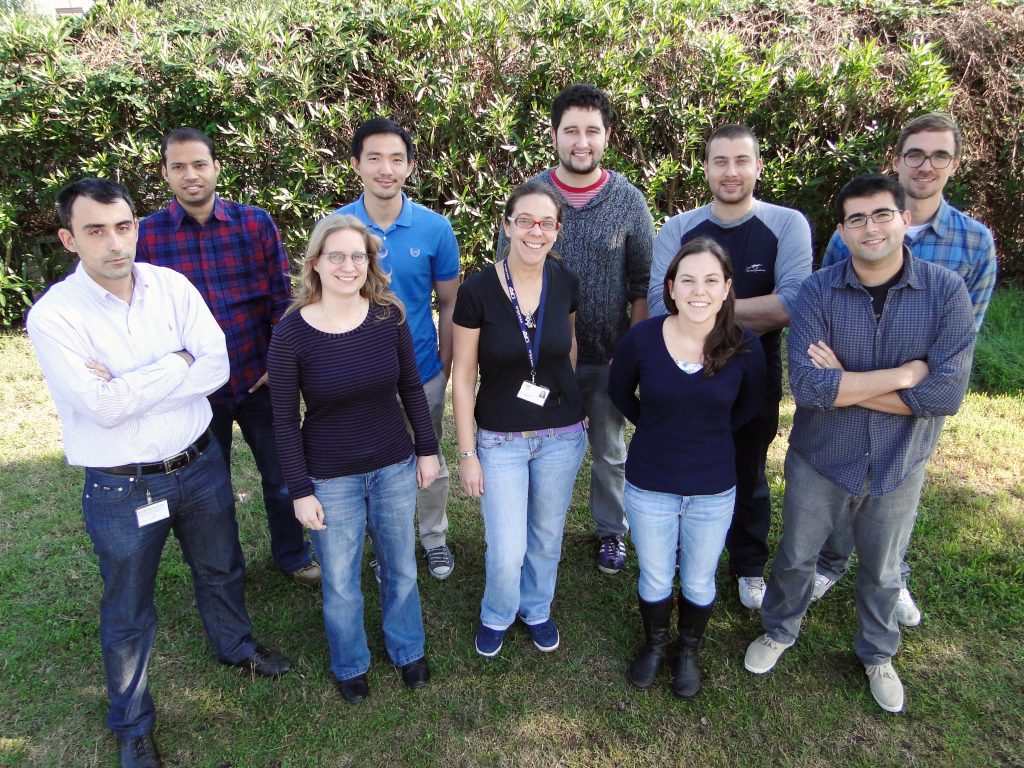2015
Plasmonic Focusing enables High-Sensitivity Quantum Dot Photodetectors

High-sensitivity photodetection is at the heart of many optoelectronic applications, including spectroscopy, imaging, surveillance, remote sensing and medical diagnostics. Achieving the highest possible sensitivity for a given photodetector technology requires the development of ultra-small-footprint detectors, as the noise sources scale with the volume of the semiconductor. This must be accomplished without sacrificing neither the optically active area of the detector nor its responsivity.
Up to now, such designs have been based on diffraction-limited approaches using optical lenses. Now, we have employed a plasmonic flat-lens bull’s eye structure (BES) to concentrate and focus light into a nanoscale colloidal quantum dot (CQD) photodetector. The work was published in the new Nature family journal Light: Science & Applications.
In this study, we developed plasmonic lenses to function as nanofocusing resonant structures that simultaneously offer color selectivity and enhanced sensitivity. The researchers have been able to demonstrate the first CQD photodetector with a nanoscale footprint, the optically active area and spectral response of which is determined by the BES. The successful development of this detector represents an exciting opportunity for high-sensitivity sensing.
Reference: Silke L Diedenhofen, Dominik Kufer, Tania Lasanta and Gerasimos Konstantatos
Integrated colloidal quantum dot photodetectors with color-tunable plasmonic nanofocusing lenses
Light, Science & Applications 4, e234
2014
Improved electronic coupling in hybrid organic-inorganic nanocomposites employing thiol-functionalized P3HT and non-toxic bismuth sulfide nanocrystals
We report in a recent article in Nanoscale how we employ a thiol-functionalized polymer (P3HT-SH) as a leverage to tailor the nanomorphology and electronic coupling in polymer-nanocrystal composites for hybrid solar cells. The presence of the thiol functional group allows for a highly crystalline semiconducting polymer film at low thiol contents and allows for improved nanomorphologies in hybrid organic-inorganic systems when employing non-toxic bismuth sulfide nanocrystals. Exciton dissociation efficiency and carrier dynamics at this hybrid heterojunction are investigated through photoluminescence quenching and transient absorption spectroscopy measurements, revealing a larger degree of polaron formation when P3HT-SH is employed, suggesting an increased electronic interaction between the metal chalcogenide nanocrystals and the thiol-functionalized P3HT. The fabricated photovoltaic devices show 15 % higher power conversion efficiencies as a result of the improved nanomorphology and better charge transfer mechanism together with the higher opencircuit voltages arisen from the deeper energy levels of P3HT-SH.
Reference: Luis Martinez, Sosuke Higuchi, Andrew Maclachlan, Alexandros Stavrinadis, Nichole Cates Miller, Silke Luzia Diedenhofen, Maria Bernechea, Sean Sweetnam, Jenny Nelson, Saif Ahmed Haque, Keisuke Tajima and Gerasimos Konstantatos
Improved electronic coupling in hybrid organic-inorganic nanocomposites employing thiol-functionalized P3HT and non-toxic bismuth sulfide nanocrystals
Nanoscale 6, 10018-10026 (2014)
Determination of carrier lifetime and mobility in colloidal quantum dot films via impedance spectroscopy
We report in a recent article in Applied Physics Letter that we employ impedance spectroscopy to determine the carrier lifetime in PbS quantum dot Schottky solar cells and we verify the validity of the technique via transient photovoltage. We also present a simple approach based on an RC model that allows the determination of carrier mobility in PbS quantum dot films and we corroborate the results via comparison with space charge limited measurements. In summary, we demonstrate the potential of impedance spectroscopy to characterize key-to-photovoltaics optoelectronic properties, carrier lifetime, and mobility, in a facile way.
Reference:
Arup K. Rath, Tania Lasanta, Maria Bernechea, Silke L. Diedenhofen, Gerasimos Konstantatos
Determination of carrier lifetime and mobility in colloidal quantum dot films via impedance spectroscopy
Appl. Phys. Lett. 104, 063504 (2014)
Heterovalent cation substitutional doping for quantum dot homojunction solar cells
We report in a recent article in Nature Communication a novel doping scheme for colloidal quantum dots that enables the development of colloidal quantum dot homojunction solar cells. Doping in colloidal quantum dots has remained a grand challenge for many years. Recent efforts have demonstrated the effect of doping in the optical properties of quantum dots, however robust electronic-active doping has remained elusive.
In this work, we demonstrated that the doping character of colloidal quantum dots can be controlled by introducing heterovalent dopant cation atoms to transform a p-type semiconductor into an n-type semiconductor. We have then shown that this can be utilized in robust solar cell structures operating under ambient conditions with respectable efficiencies.
Reference: Alexandros Stavrinadis, Arup K. Rath, F. Pelayo García de Arquer, Silke L. Diedenhofen, César Magén, Luis Martinez, David So, Gerasimos Konstantatos
Heterovalent cation substitutional doping for quantum dot homojunction solar cells
Nature Communications, doi: 10.1038/ncomms3981
EOS Topical Meeting on Optics at the Nanoscale
I have presented my recent findings at the 1st EOS Topical Meeting on Optics at the Nanoscale in Capri, Italy.
High-Efficiency Solar Cells
The book High-Efficiency Solar Cells – Physics, Materials, and Devices,Series: Springer Series in Materials Science, Vol. 190 by Wang, Xiaodong; Wang, Zhiming M. (Eds.) has been recently published and includes our chapter Broadband and Omnidirectional Anti-reflection Coating for III/V Multi-junction Solar Cells.
Solution-processed hybrid organic-inorganic bulk heterojunction solar cells

In collaboration with researchers from the Department of Applied Chemistry at University of Tokyo, we demonstrated solution-processed hybrid organic-inorganic bulk heterojunction devices employing P3HT in conjunction with bismuth sulfide nanocrystals as the electron accepting material. These devices attain power conversion efficiencies of 1% extending at the same time the sensitivity of P3HT into near-infrared wavelengths. The reported infrared sensitization levels of 30% are among the highest ever reported with P3HT.
Reference: L. Martinez, A. Stavrinadis, S. Higuchi, S. L. Diedenhofen, M. Bernechea, K. Tajima, G. Konstantatos
Hybrid solution-processed bulk heterojunction solar cells based on bismuth sulfide nanocrystals
Phys. Chem. Chem. Phys. 15, 5482-5487 (2013)
The book High-Efficiency Solar Cells – Physics, Materials, and Devices,Series: Springer Series in Materials Science, Vol. 190 by Wang, Xiaodong; Wang, Zhiming M. (Eds.) has been recently published and includes our chapter Broadband and Omnidirectional Anti-reflection Coating for III/V Multi-junction Solar Cells.
2012
FOM Valorisation Chapter Prize

The FOM Valorisation Chapter Prize 2011 has been awarded to me. The jury was struck by how I creatively translated my work in the area of nanowires to a broader market. The prize will be presented on 17 January 2012 during the congress Physics@FOM Veldhoven.
I described in my valorisation chapter the possible applications of semiconducting nanowires, such as the improvement of existing solar cells and a new type of solar cell. “Diedenhofen has come up with good ‘out of the box’ ideas and has identified applications in various areas. These applications concern broad societal problems and have the potential for general market applications,” said the jury.
Watch the video of the award ceremony on You Tube.
Marie-Curie Fellowship
I have been granted a Marie-Curie inter-european fellowship for my project plasmonically enhanced quantum dot photodetect at the Solution-processed nanophotonic devices group.

